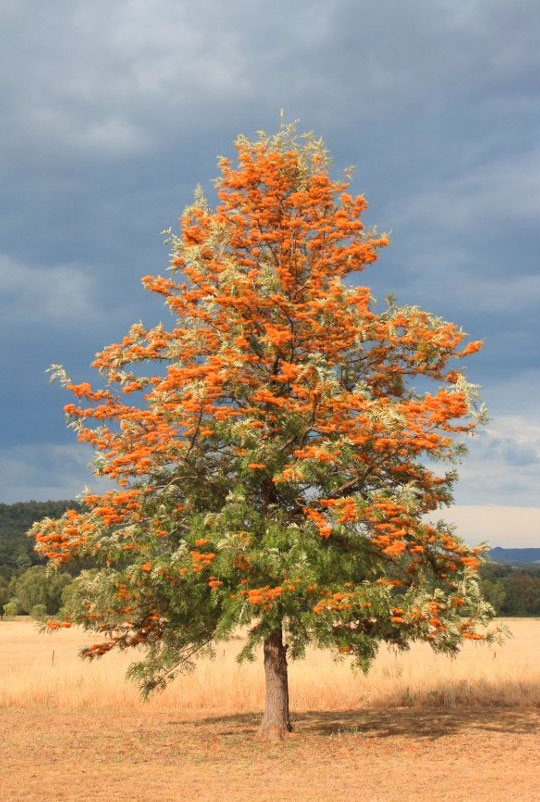Grevillea Robusta (Silky Oak) is the largest tree species under the genus Grevillea within the remarkably trim family Proteaceae. Sometimes named Silky Oak or Southern Silky Oak, the plainly distinct tree isn’t even remotely related to the ubiquitous oaks we all know. The deceptively titled plant is indigenous to eastern parts of coastal Australia, primarily thriving in riverine climes of the far-flung country. 
The ideal surrounds for the species natural growth and optimal flourishing lies somewhere between rain-forest environments and subtropical overgrowths that receive at least 1,000 mm of rainfall annually. The principally evergreen tree grows incredibly faster than most other widespread staples cultivated by Australian arborists. It’s distinguished foliage resembles fern fronds and assumed a bipinnatifid representation.
A mature Silky Oak grows to an average height of between 59 to 115 ft. Marked as the leading plants within the Grevillea genus in terms of trunk diameter, their ideal girth winds an estimated 3 ft. The fur-like leaves stretch to a typical length of about 6 to 12 inches. The leaves can always be dependably differentiated from other similar-looking foliage shapes on the basis on their rust-coated/slightly whitened undersides.
Whenever at its blooming peak, Grevillea Robusta flowers attain a tellingly outstanding golden-orange tinge, formed in bottle-brush shaped clusters that one can conspicuously espy from afar. These naturally enticing blooms are variously utilised for versatile purposes. Most importantly, the alluring wild bouquets are a vital source of nectar to which hordes of industrious 12 week shred diet plan bees massively flock to throughout spring.
Nonetheless, those a little familiar with the outlook of this genus have already discovered that Silky Oak flowers feature a stark absence of petals. In the place of a beautiful petal, the bloom consists of an unbeatably longer calyx that breaks into four separate lobes. The tree’s seeds ripen sometime between late winter and early spring. Fruition takes place on skin-resembling dehiscent follicles, measuring about 2 centimetres and flat-winged seeds that appear rather dark-greyish in colour.
A few centuries ago, Grevillea Robusta timber gave way to the use of aluminium in external window joints as a galvanising agent that toughened wood against possible decay. Even today, some modern carpenters occasionally put Silky Oak wood pieces to this majorly dated purpose due to a number of uniquely varying reasons.
While this auspicious tree produces excellent timber, for crafting furniture such as cabinets, felling remains outlawed so as to preserve the worryingly dwindling natural reserves nationally. Owing to its unmatched aesthetic and tonal attributes, the species has been used to fashion top-tier guitars in the country and even beyond.
Finally, Silky Oaks may be successfully grown as house plants under limited sunlight. Regardless of this fact, it ought to be noted that the genus does better when cultivated in areas that receive unlimited amounts of sunlight. As a worthy precautionary tip, growers and experimenting arborists shouldn’t overlook the danger the plant’s foliage presents.
These narrow and longish leaves contain fatal amounts of hydrogen cyanide. Also, be keen not to overlook the dire warning that the enigmatic species also features doubly harmful tridecylresorcinol percentages – universally blamed for numerous epidermal complications such as contact dermatitis.